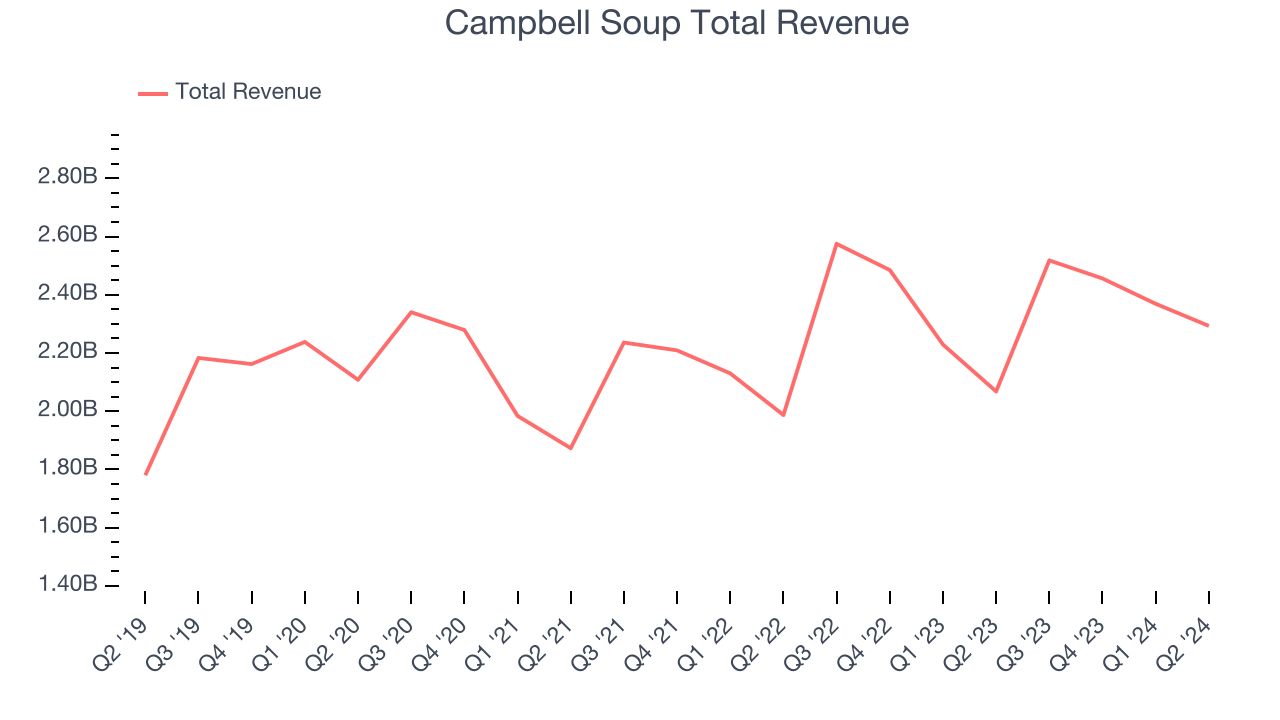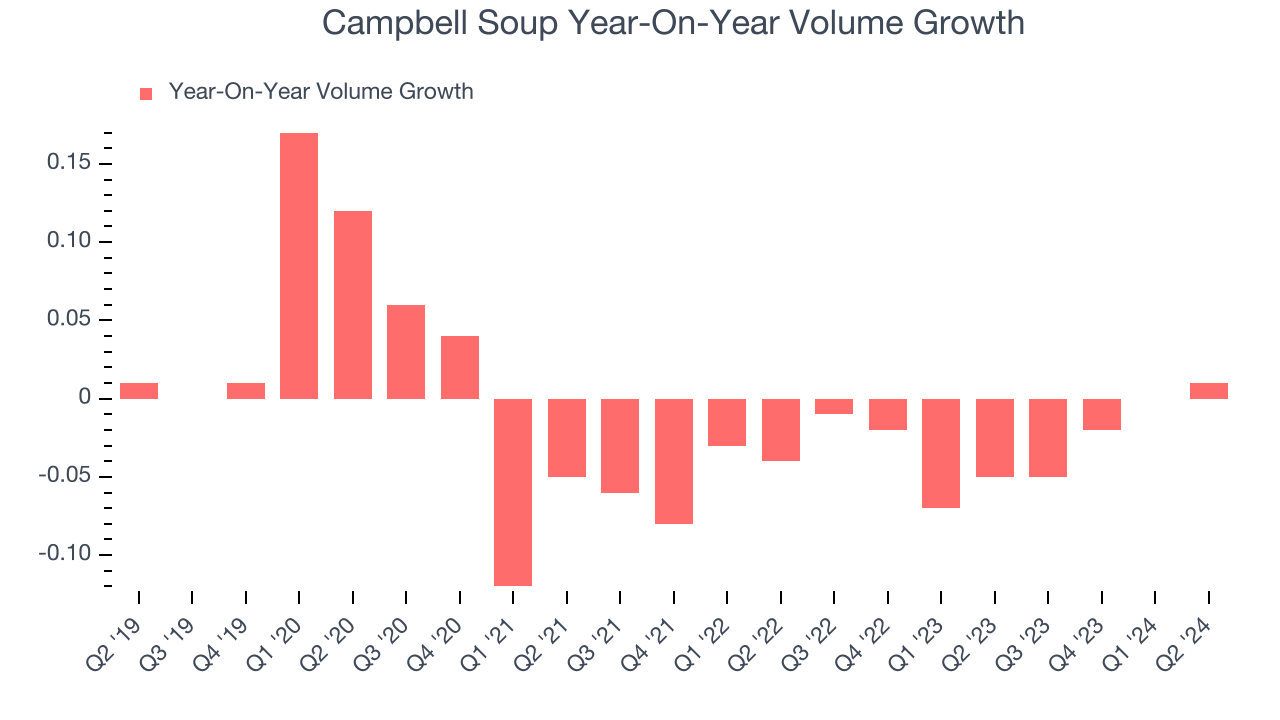Packaged food company Campbell Soup (NASDAQ:CPB) missed analysts’ expectations in Q2 CY2024, with revenue up 10.9% year on year to $2.29 billion. It made a non-GAAP profit of $0.63 per share, improving from its profit of $0.50 per share in the same quarter last year.
Is now the time to buy Campbell Soup? Find out by accessing our full research report, it’s free.
Campbell Soup (CPB) Q2 CY2024 Highlights:
- Revenue: $2.29 billion vs analyst estimates of $2.31 billion (small miss)
- EPS (non-GAAP): $0.63 vs analyst expectations of $0.62 (in line)
- EPS (non-GAAP) guidance for the upcoming financial year 2025 is $3.17 at the midpoint, missing analyst estimates by 1.9%
- Gross Margin (GAAP): 29.4%, down from 32% in the same quarter last year
- EBITDA Margin: 12.6%, down from 16.7% in the same quarter last year
- Free Cash Flow Margin: 6.4%, similar to the same quarter last year
- Organic Revenue fell 1% year on year (5% in the same quarter last year)
- Sales Volumes rose 1% year on year (-5% in the same quarter last year)
- Market Capitalization: $14.98 billion
With its iconic canned soup as its cornerstone product, Campbell Soup (NASDAQ:CPB) is a packaged food company with an illustrious portfolio of brands.
Shelf-Stable Food
As America industrialized and moved away from an agricultural economy, people faced more demands on their time. Packaged foods emerged as a solution offering convenience to the evolving American family, whether it be canned goods or snacks. Today, Americans seek brands that are high in quality, reliable, and reasonably priced. Furthermore, there's a growing emphasis on health-conscious and sustainable food options. Packaged food stocks are considered resilient investments. People always need to eat, so these companies can enjoy consistent demand as long as they stay on top of changing consumer preferences. The industry spans from multinational corporations to smaller specialized firms and is subject to food safety and labeling regulations.
Sales Growth
Campbell Soup is one of the larger consumer staples companies and benefits from a well-known brand, giving it customer mindshare and influence over purchasing decisions.
As you can see below, the company’s annualized revenue growth rate of 4.4% over the last three years was sluggish as consumers bought less of its products. We’ll explore what this means in the "Volume Growth" section.

This quarter, Campbell Soup’s revenue grew 10.9% year on year to $2.29 billion, falling short of Wall Street’s estimates. Looking ahead, Wall Street expects sales to grow 8.6% over the next 12 months, a deceleration from this quarter.
When a company has more cash than it knows what to do with, buying back its own shares can make a lot of sense–as long as the price is right. Luckily, we’ve found one, a low-priced stock that is gushing free cash flow AND buying back shares. Click here to claim your Special Free Report on a fallen angel growth story that is already recovering from a setback.
Volume Growth
Revenue growth can be broken down into changes in price and volume (the number of units sold). While both are important, volume is the lifeblood of a successful staples business as there’s a ceiling to what consumers will pay for everyday goods; they can always trade down to non-branded products if the branded versions are too expensive.
To analyze whether Campbell Soup generated its growth from changes in price or volume, we can compare its volume growth to its organic revenue growth, which excludes non-fundamental impacts on company financials like mergers and currency fluctuations.
Over the last two years, Campbell Soup’s average quarterly sales volumes have shrunk by 2.6%. This decrease isn’t ideal as the quantity demanded for consumer staples products is typically stable. Luckily, Campbell Soup was able to offset fewer customers purchasing its products by charging higher prices, enabling it to generate 4.4% average organic revenue growth. We hope the company can grow its volumes soon, however, as consistent price increases (on top of inflation) aren’t sustainable over the long term unless the business is really really special.

In Campbell Soup’s Q2 2024, year on year sales volumes were flat. This result was a well-appreciated turnaround from the 5% year-on-year decline it posted 12 months ago, showing the company is heading in the right direction.
Key Takeaways from Campbell Soup’s Q2 Results
We struggled to find many strong positives in these results. Its organic revenue and full-year EPS guidance missed Wall Street’s estimates. Overall, this was a mediocre quarter. The stock traded down 1.5% to $49.43 immediately following the results.
Campbell Soup may have had a tough quarter, but does that actually create an opportunity to invest right now? When making that decision, it’s important to consider its valuation, business qualities, as well as what has happened in the latest quarter. We cover that in our actionable full research report which you can read here, it’s free.
